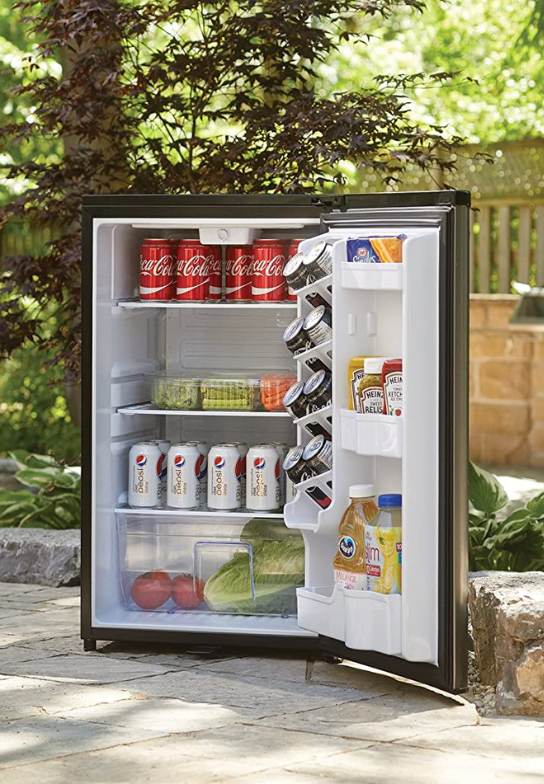Content Summary
Finding the right place for your mini fridge might take a bit of planning. There are many factors you need to consider to ensure your mini fridge is working efficiently and stays in good condition.
In this guide, we'll share with you all the information you need to know about where to put your mini fridge, where not to put it, and the factors and rules you need to consider. Check them out!


Where To Put A Mini Fridge
The best place to put your mini fridge is in a well-ventilated area, where there is enough space between the fridge and the wall or other objects to allow free air circulation.
Make sure it will sit upright: the right surface for a fridge is flat and level. Considering the space, temperature, hygiene, convenience, and safety measurements, you can ensure that your fridge is easily accessible and energy-efficient.
1. Indoor vs Outdoor
The first decision you need to make is whether you want an indoor or outdoor mini fridge.
- Indoor fridges are placed inside the house where the temperature is controlled, and there are no weather conditions to contend with. These fridges are designed to be used in the kitchen, bedroom, and living room inside a house or apartment.
- Outdoor fridges are designed to be more durable than their indoor counterparts, and can withstand weather changes. They can be used in an outdoor kitchen, pool area, backyard, garage or patio.


2. Kitchen
One of the most popular spots for a mini fridge is the kitchen.
- This makes sense as the kitchen is the hub of a home and is where most people spend a lot of their time.
- If you have limited space, consider placing your mini fridge under the countertop or in a corner. This keeps it out of the way while still being easily accessible.
- If you have more space, you can also opt for a standalone fridge or one that doubles as a beverage center.


3. Bedroom
- If you spend a lot of time in your bedroom or require an additional fridge for the nursery at night, then a mini fridge might be a good addition.
- You can keep cold water, milk, medication or skincare products that require cooling nearby, without having to go all the way to the kitchen.
- Just make sure you choose the low noise (low db) fridge to avoid any unnecessary noise and enjoy a good sleep.



4. Home Office
If you work from home then it's a great addition.
- For an office, you can place it under your desk, on a shelf, or even on top of a filing cabinet.
- When you place it on a shelf or cabinet, it's advised to place a rubber mat underneath to avoid noisy vibrations when the fridge turns on.
- When your home office has a carpeted floor, place the fridge on a flat and level surface, like a stable wooden base, or a hard-plastic mat. Not only to avoid damage to your carpet, but also to ensure ventilation.
- It's great for storing drinks and snacks to keep you going throughout the day.


5. Garage
- The garage is another popular spot for a mini fridge, especially if you have a workshop or gym facilities.
- You can store cold drinks or protein shakes without having to trek back and forth to the kitchen.
- However, be mindful of the temperature in your garage. If it gets too hot or too cold, your fridge might not work properly.
- A garage fridge should be well-insulated. Better: a specialized outdoor fridge that can withstand extreme temperature changes.


Where Not To Put A Mini Fridge
The safety of your mini fridge should be a top priority. There are several places you should avoid placing your mini fridge.
Direct Sunlight Or Heat Source
- Placing it in direct sunlight or near any heat source, such as a radiator or oven, is a bad idea.
- The heat can damage the mini fridge, as it will cause the fridge to work harder to keep its contents cool. Overheat means "overwork": it leads to higher energy costs and potentially a reduced lifespan.
Unventilated Areas
- Mini fridges require proper ventilation to keep them running efficiently.
- If a mini fridge is placed in an enclosed area, such as a closet or cupboard, the outside heat won't be able to escape, and could lead to the fridge overheating.
- Do not place a mini fridge in a tight space without ventilation. This may block the airflow and cause overheating.
- Also, you better not place the mini fridge on a carpeted surface, as the carpet can trap heat and insulate the fridge leading to reduced efficiency.


Factors & Rules To Consider
When deciding where to place your mini fridge, consider the following factors and rules to ensure it stays in good condition and runs efficiently.
1. Safety First
- Safety should always be a top priority. This means avoiding placing it in areas where it could easily be knocked over, or where it could pose a tripping hazard.
- Although modern fridges are relatively safe appliances, there is always a remote fire risk that may be due to faulty wiring or plug (short-circuit), or a compressor oil leak. Active maintenance is vital to safety.
- If you have small children or pets in your home, you’ll want to ensure that your mini fridge is located in an area where it cannot be easily opened. When in doubt, consider putting a lock on the fridge door.
2. Consider Space Constraints
- Place it in a location where it won’t impede people traffic flow or take up too much valuable floor space.
- Make sure that the surface you plan to put your mini fridge on is level; avoid a tilted surface.
- If you live in a small apartment or dorm room, some good options may include under a desk, in a corner, below or on top of a countertop.
3. Away From Heat Sources
- It’s important to avoid placing your mini fridge near any sources of heat, such as heaters, or ovens.
- This is because heat can cause your fridge to work harder than necessary, leading to higher energy bills and potentially even damage to the fridge itself.
- Wiring can melt in the presence of heat, which can cause a fire.
- If your fridge is located near a heat source, it may struggle to maintain a consistent temperature, resulting in spoiled food.
4. Consider Hygiene
- It is also not advisable to install your mini fridge near a bathroom or toilet, as humidity and moisture in these areas could cause damage to the fridge motor.
- Ensure that the space you choose is clean and free of dust or debris. This will keep the fridge's compressor coils free of debris, improving its efficiency and lifespan.
- Make sure that the area around the fridge has enough space to allow for maintenance, cleaning, and repair if needed.
- First, unplug. Then defrost your fridge, so it can be cleaned to clear out any food scraps and spilled beverages, and to remove accumulated ice. Do this on a regular basis, say, at least once every 6 months.
5. Think About Convenience
Convenience means, your mini fridge is easily accessible.
- If you’re planning on using it primarily for drinks and snacks, you may want to place it in a location that’s easily accessible from your living room or bedroom.
- If you plan on using it primarily for storing extra groceries, you may want to put it in your kitchen or pantry for easy access.
Need a quality mini fridge? Check out our selection of top brands and designs. From indoor to outdoor models, from beverage coolers to glass door units, we have picked the perfect refrigerator for any space.

By following these factors and rules, you'll be able to find the perfect spot for your mini fridge to provide you with cold drinks, snacks, and food whenever you need them. Happy chilling!
Catchy Finds
















